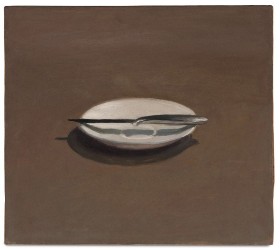
NEW YORK – Mesmerizing images by Vija Celmins (b. 1938-) have captivated viewers of her artwork, whether paintings, prints, drawings or sculptures, for over 50 years since the Latvian-born artist first made her mark on the art scene. Her strikingly realistic photograph-based paintings and drawings of the natural world – the ocean, desert and night sky stars being three of her most iconic subjects – were instant hits and likened comparisons to Gerhard Richter.
The subject of many solo exhibitions in her career, Celmins was celebrated in 2019 in the first major retrospective in over 25 years. It ran at several museums, including the Met Breuer in New York and the San Francisco Museum of Modern Art. While the artist often creates her art after meticulous and direct observation, she is best known for a unique process she refers to as “redescription,” where she translates photographs from one medium to another. Whether she is depicting the magnitude of the ocean, a beach or the night sky, viewers are compelled to look closer and deeper into the artworks, perhaps even deeper into themselves.

In a press release for that exhibition, Max Hollein, director of the Met, opined that Celmins is one of the most important artists in the last six decades and that her work has a timeless quality. “Celmins’ exquisite compositions invite us to stop, look, concentrate, and rediscover the world that surrounds us — and her —anew,” he said.
A traumatic childhood growing up in Latvia during World War II influenced her art. She and her family came to the United States in 1948 at age 10 and she grew up in Indiana. Studying art at the John Herron Art Institute in Indianapolis (1955-1962), she decided in 1961 to become a painter and settled in California. She began by painting ordinary objects in her Los Angeles studio to translating images from history books and magazines before finding her greatest inspiration in the natural world.

In a video interview for that 2019 exhibition, aptly titled “Vija Celmins: To Fix the Image in Memory,” the artist described her process. She said that she tries to use images that attract one to a painting and makes the viewer want to go into the painting. The painting is not a window and creates its own reality, she said, noting that she is not interested in telling stories through her art but capturing the emotional quality of a painting. A master printmaker, who first studied printmaking as an undergraduate, she uses a variety of techniques, including lithography, drypoint, silkscreen, woodcut, wood engraving and mezzotint. She also uses a variety of different mark-making styles from dots to smidges and waves, to create her artworks and has fluctuated between oil painting and graphite pencils back to oils.

Art curator Neville Wakefield has noted the artist is not captivated by the magnificence of the desert or ocean in its totality but instead hones in on surface tensions on each surface, which share striking visual similarities. “The seascapes, like the desertscapes, though transcribed from photographs that the artist would take from the pier on Venice beach or her walks in Death Valley, are also depictions of all seas, and all deserts,” he said.
Representing Celmins’ work for a few years now, New York’s Matthew Marks gallery recently featured an exhibition of 15 of her ocean prints, noting that the ocean’s surface was a key motif in her oeuvre. In the 1960s, Celmins had a studio in Venice, Calif., and would take walks along the pier to photograph the ocean that she later drew or painted. “By framing the subject carefully, cropping out the shore and the horizon, she creates an unbroken composition that seems to extend in every direction,” the gallery wrote in a press release.

Demand for Celmins’ works has been steady, with her detailed drawings often holding the most appeal for collectors. Several of her drawings have sold in recent years for over $3 million, and the current record is held by her ocean drawing, Lead Sea #2, which made $4.2 million at a Christie’s New York auction in November 2017.
Renowned for her ability to create images that are both distant yet intimate, Cemins brings what is vast down to a scale the human eye can process. Such a dichotomy is a common thread running through her work. Reflecting on the past and using photographs (be they from history books or images she shot decades ago) to make contemporary images and imbue the photos with new life, she merges the past with the present.
# # #



